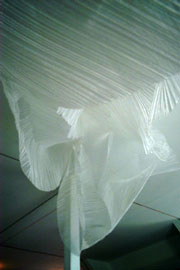
"... recycling allows the same materials to be transformed from one object to another, such that the materials "move"... through culture. Culture becomes nothing more than the organization of such flows..."
"Images are literally consumed as a form of nutrition... As the body expands, the environment is literally brought inside. Space gets reconstituted. Architecture is what you swallow." (Wigley, M in A. Marras, 1999)GroWorld is an initiative that started within FoAM in Brussels. It encourages multidisciplinary discussions, bringing different research topics into a common focus: 'growth processes' in (physical and virtual) life. GroWorld is currently developed in three parallel trajectories: socio-cultural (sym), ecological (bio), technological (sys). The trajectories are mutually independent, but complimentary, with their results being integrated into several experiments and projects.
sym [Dylan Thomas -- the Force That Through the Green Fuse...]
GroWorld's cultural trajectory comprises artists and designers interested in 'biomimetics', learning from nature to design responsive spaces and objects. Nature is not taken as something pure and innocent, but as the substance and action that grows through the cracks of the extreme, and potentially hostile environments - such as urban spaces, polluted areas (Chernobil Eco System), bathyscopic bottoms of oceans, volcanic fluxes. More specifically, this "sym" strand examines growth and adaptation processes in audiovisual media, material, object and environment design and realizes such processes as experiments in mixed reality installations, a-life environments and smart textiles.
While being informed by the current understandings of morphogenesis of living organisms, such as plants or swarm populations, this research does not attempt to replicate biological patterns, structures or behaviors. Instead, it looks for emergent properties of growing synthetic life forms: visual worlds, sonic structures and responsive materials. Currently, the research explores materials such as artificial muscle technologies and electrostatic polymer gels for the creation of more 'flexible' architectures of public spaces and processes such as cell signaling and bioluminescence that could be used in the design of responsive media and materials.
bio
Biopiracy is one of the most menacing by-products of the global economy.
Several transnational biotech concerns have elaborate intellectual property
mechanisms that endanger the evolution of flora and fauna worldwide. This
process has its roots in the colonial era, when the indigenous plants
and animals were treated as scarce exploitable resources, and whole species
were exterminated before the local popular constituencies could act. Furthermore,
small farmers and horticulturalists, unable to compete with the large
industries have been forced to breed monocultures that diminished the
genetic diversity of the local ecology. Today, the transgenic crops are
not only slowly wiping out the existing eco-systems, they cause quick
and drastic mutations in some plants and animals, rupturing the habitat's
balance. The local farmers are discouraged from cross-breading and developing
new species, as they might be infringing a patent and consequently could
be prosecuted. This all may sound like a science fiction recipe of eco-disaster,
according to which the Earth strikes back by growing an army of macrophages
that threaten to destroy the human race. Fortunately, there are several
local and global movements that are monitoring these affairs, and are
acting upon them on different levels. GroWorld proposes a small addition
to these valuable efforts.
The ecological strand of GroWorld involves building a trans-local network
of public gardens concerned with sustaining local bio-diversity. Around
the globe, there are several private and communal gardens grown by local
scientists, landscape architects and neighborhood communities. They are
sites evolving on their own accord - becoming patches of autonomous organic
wilderness in the midst of an urban jungle, grown and molded by their
care-takers and temporary dwellers. However, they are too often isolated,
overlooked or taken for granted.
GroWorld will attempt to map these weedy actions, that have managed to
grow beneath the radars of the transnational biopirates, bring these gardens
in contact sponge with each other, so that instead of being private and
isolated utopias, they form parts of a diverse, worldwide distributed
habitat, connected via the contact sponge and exchange of the people involved.
The symbiotic relationship between the physical gardens and communication
technologies develops in a spontaneous and autonomous manner.
(Autonomous does not equal uncontrolled,
or totally unconstrained. We can see the effects of such development in
the sprawls of Los Angeles and Atlanta and residential districts built
after WWII in Italy)
An evolving map, based on principles from Buckminster Fuller's Dymaxion
Map that "reveals a One-World Island in a One-World Ocean" (www.bfi.org)
- rendering this distributed wilderness as interconnected, rather than
divided by arbitrary historical or economic boundaries.
Some of the
gardens will sprout from the locales of GroWorld participants. They are
devised both as growing environments in which the visitors can comfortably
linger, surrounded by specific local flora, and instruments allowing their
players to collaboratively shape and steer the environment's processes
of growth, decay and transformation.
This strand is currently in the process of feasibility research and informal
contact sponges with communities in several localities, such as Belgium,
the Netherlands, Austria, Croatia, UK, USA and Australia.
sys
The strand that will potentially be most useful across of a variety of
public spaces is the "sys" technological strand of GroWorld.
Its results should be accessible to different communities and should be
adaptable for several social, ecological and cultural contexts - adaptable
to both indoor and outdoor spaces, different climates and cultures. The
overall objective of this work is to enhance existing public wildernesses
with interactive media and technologies. Social interaction and communication
determine function and form of these spaces, and should therefore become
a crucial part of technological development.
[The purpose of this work is to identify, analyze and incorporate studies
of different types of informal or conversational public activities, that
are less based on rules and more on improvisatory and social interaction.]
The specificity of public spaces demands a high degree of adaptive capabilities
from the technologies to be integrated within them, such as sensitivity
to context, climate and culture. Christopher Alexander, in his book, The
Timeless Way of Building, considered every space as becoming alive through
events that were induced by the geometry of that space. Schematizing Alexander's
description, the geometry of a public space helps give a shape to the
imagination of its visitors, the imagination inspires the behavior, and
the behaviors build the events. Mixed reality technology introduces one
new element in this experiential spiral: the synthetic responsive media
logic infusing the space, the imagination, the anticipation and the event.
Adding computational functionality to already existing elements of a public
space augments ordinary objects which become able to interact with their
surroundings and evolve based on that interaction.

Examples of materials
developed by Evelina Kusaite,
based on movement
organs
of shrimp and jelly fish


Dymaxion Map: http://www.geni.org/
energy/library/buckminster_fuller/
dymaxion_map/
dymaxion_projection.html
 Visualisation and
navigation
Visualisation and
navigationdiagrams from: http://www.caida.org/
tools/visualization/walrus/
back to sponge >